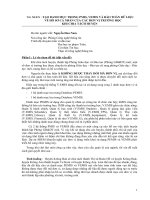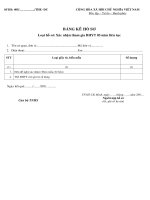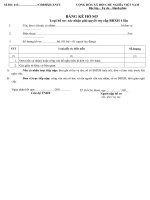hồ sơ cá nhân
Bạn đang xem bản rút gọn của tài liệu. Xem và tải ngay bản đầy đủ của tài liệu tại đây (125.28 KB, 7 trang )
1
THE 28
TH
CONFERENCE OF THE FEDERATION OF ENGINEERING
ORGANIZATIONS
CAFEO 28 HANOI VIETNAM, 30
TH
NOV. - 2
ND
DEC., 2010
TITLE:
Preliminary results in research and technology transfer
of by-product utilization for higher income and lower
CO2 emission
YOUR PHOTO
(or you can
attach a
separate file for
photo)
AUTHOR(S)’
NAME(S):
Nguyen Quoc Viet, Chu Van Thien, , Dau The Nhu, Do
Ngoc Huyen, Trinh Van Trai, Nguyen Thi Lan Huong
ORGANIZATION
&
DESIGNATION:
Vietnam Institute of Agricultural Engineering & Post-
Harvest Technology
ADDRESS:
126 Trung Kinh, Cau Giay, Hanoi
TEL:
+ 844 3868 7884
FAX:
+ 844 3868 9131
EMAIL:
Preliminary results in research and technology transfer toward by-product utilization for
higher income and lower CO2 emission
Nguyen Quoc Viet
*
, Chu Van Thien, Dau The Nhu,
Do Ngoc Huyen, Trinh Van Trai, Nguyen Thi Lan Huong
Vietnam Institute of Agricultural Engineering and Post-Harvest Technology (VIAEP)
Abstract
Vietnam has an abundant source of by-products from agricultural production activities like rice
straw, stubble, hush, sawdust, baggase, coffe pulp, cashew apple and nut shell, etc. These by-
products are mostly burned, discarded as ash or rubbish, even poured to rivers causing economical
waste and environmental pollution. Facing to the situtation, during last four years Vietnam Institute
of Agricultural Engineering and Post Harvest Technology has conducted some bellow studies for
the utilization of agro by-products and obtained highly applicable results:
(i)
Fluidized bed combustion technology burning by-products to supply energy for drying agro-
products
(ii)
Technonogy and equipments for gathering, preservation and processing of rice straw
(iii)
Appropriate technology and equipments for production of particleboard from rice straw and
short fibre of coconut shell
(iv)
Production of fermented coffee pulp at industrial scale to provide suplemental feed for animal
husbandry
Technologies and equipments from the the studies are being transfered succesfully to manufacturers
and farmers.
Key words: forest, agro by-products, utilization, fluidized bed combustion, rice straw, husk, coffee pulp, particleboard,
(*) Corresponding author: Tel: +84438687884, E-mail:
, Add: VIAEP, 126 Trung Kinh str.,
Cau Giay dist., Hanoi, Vietnam
2
I. INTRODUCTION
In Vietnam, the agricultural sector is the main source of income for the majority of people and its
future performance will continue to be the main factor influencing the living standards of Vietnamese
(Ogle & Phuc 1997). Agro and forest by-products coming from activities of forest and agricultural
processing and production are available locally in large amounts.
Rice straw and husk: Rice is the predominant food grain with 2-3 crops per year in Vietnam with
yield of 38 million tons (2008). Rice straw and husk produced every year is plentiful. According to a
case study carried out in the countryside of Hanoi on 5 rice varieties (Nguyen Xuan Trach,
unpublished data), on the average 0.83 kg straw and around 0.2 kg of husk is produced together with
each kilogram of paddy grains. Based on these figures, 25-30 million tonnes of straw and above 7
million tons of husk could be expected every year now in Vietnam. Vast amounts of this renewable
resource are burnt either in the field or as cooking fuel. Some is used for other purposes such as litter,
mushroom production, etc.
Coir dust and short fibre of coconut shell: Coconut palms are cultivated mainly in Ben Tre and Tra
Vinh provinces with a total area of 48,000 ha (Nien giam thong ke, 2005) producing 254 million
coconuts. For a ripened coconut, the shell takes 33-35% in which coir dust and short fiber take 70%.
If average weight of coconut is 1.6 kg/fruit, there would be hundred thousands of tons of coir dust and
short fible of coconut shell. Coir dust is often used used as supporter for seedling or to make clean
clay. Short fibre has not been utlized for any other purposes, it is discarded causing water and air
pollution.
Coffe pulp: Annually, average productivity of fresh coffee bean in Vietnam is estimated around
850,000 tons/year and accompanied coffee by-product amount is around 340,000-350,000
tons/year. Coffee pulp accounts for 40% weight of coffee fruitt. Coffee pulp containing high
content of moisture (80-85%), proteins, carbonhydate, vitamins, mineral elements provides good
environment for microbial development (Juan, 2002). Coffee pulp also contains anti-nutritional
substances like caffeine and tannin making it difficult to be used in animal feed. The by-product is
usually untreated before discarded causing serious pollution problems in the air, land and water
source.
Current trends towards sustainable agriculture under protection of the environment may highlight the
need to improve utilisation of agro and forest by-products. Additionally, utilisation of forest and agro
by-products provides more job oppotunities, not only ecological but also economic efficiency,
reduces the natural resource exploitation, etc. In the reality, studies to find out scientific and
technological solutions for better utilisation of the vast amount of such renewable sources in Vietnam
are definitely neccessary and urgent. Since last five years, Vietnam Institute of Agricultural
Engineering and Post-Harvest Technology (VIAEP) has paid much attention in technology research
and transfer towards utilization of forest and agro by-products for better economic and ecological
efficiency.
II. SOME RESULTS OF TECHNOLOGY RESEARCH AND TRANSFER TOWARDS
UTILIZATION OF FORESTRY AND AGRO BY-PRODUCTS
1. Fluidized bed combustion technology burning agro by-products to supply heat for drying
and processing of agro products
Fluidized bed combustion system (FBC) has been succesfully studied on its structure and technical
parameters for burning agricultural residues like rice straw, coffee husk, sawdust. This is the first
FBC in Vietnam that is designed and used to burn by-products and release heat for drying some
agro-products such as rice, maise, coffee, fruits and vegetables. Additionally, FCB burning by-
3
products is also used to supply heat for drying wood, constructional materials; supply ash for
cement production.
Main technical parameters of the FBC was established as follows:
- Input (rice straw, coffee husk, sawdusk): 50-70 kg/h
- Size: 0,465 x 0,465 m
- Height of burning space: 1,656 m
- Caloriphere: 43 pipes
- Fan: 600 m3/h, pressure H=700 mm H2O
Operation of FBC is illustrated in Figure 1. Agricultural residues are burnt in burning chamber (5).
High pressure fan (3) and suction fan (9) lead to presure change in the chamber to make sand
boiling. Gas for burning is supplied by high pressure fan (3) in primary and secondary flows.
Primary gas flow is suplied through pipes. Secondary gas flow is supplied above the sand layer to
get more oxygen for better burning. Burning chamber connects with an auxiliary deposit chamber
(6). Ash deposit is separated to the deposit chamber and heated gas flow goes to heat exchange
equipment to transmit heat to the air which afterward acts as the drying agent in the drying
chamber.
Economic and social efficiency of using FBC: Application of FBC for 7 ton/batch dryers lowered
total cost 70% compared to coal burning system. In details, cost of FBC system for the mentioned
dryer to was 13,800 VND/hour while total cost of coal burning system for the dryer was 43,800
VND/hour.
Technology transfer: FBC systems have been transfered into production and in good operation:
- 4 systems burning rice straw and coffee husk release heat to dry rice, coffee, maise and cassava
waste, capacity 60 and 120 kg/h of agicultural residues , in Gia Lai coffee company and N&N
company in Gia Lai, Son La and Ha Tay provinces
- 3 systems burning rice straw to release heat and ash for high quality cement production,
capacity: 600, 1200, 1500 kg/h. The systems replace FO burning oven in Holcim company,
Hochiminh city (Fig. 2)
7
2. VÝt t¶i cÊp liÖu
4. Van ®iÒu chØnh
6. Buång l¾ng bôi
8. cyclon l¾ng bôi
1. si l« chøa liÖu
1
3. Qu¹t lß
2
34
56
5. Buång ®èt
7. calorife
9. qu¹t
hót
T¸c nh©n sÊy
kh«ng khÝ
8
9
Fig.1. Operation schema of a FBC system
1. MATERIAL STORAGE SILO
2. MATERIAL FEEDING SCREW
3. OVEN FAN
4. ADJUSTING SCREW
5. BURNING CHAMBER
6. DUST TRAPPING TANK
7. CALORIPHERE
8. TRAPPING CYCLON
9. SUCTION FAN
4
Fig. 2. FBC burning rice straw installed in Holcim cement company, Hochiminh city;
Capacity: 600; 1200 và 1500 kg/h
2. Technology and equipment system for gathering, storage and processing of rice straw for
better utilization
Rice straw is a by-product available in a significant quantity in rice production. Rice straw is a good
source to produce various products like organic fertilizer, animal feed, material for paper
production, etc. In Vietnam, utilization of rice straw is not yet paid attention and in spontaneous
approach. Rice straw in the field is gathered by human labor. The amount of gathered straw is
inconsiderable. Most of rice straw is burnt in the field or self-degraded causing environment
pollution. Facing with the practical situation, demands of technology and equipment system at
industrial scale for gathering, packing, storage and processing of rice straw is much neccessary and
urgent to give more comprehensive measures, increase economical and social efficiency,
contribute to agricultural and rural industrilization as well. The governmental project titled: Study
on technology and equipment system for gathering, storage and processing of rice straw for better
utilization, coded KC.07.10/06-10, has been managed and implemented in VIAEP. Some
achievements of the project are as follows:
- Technological processes: mechanization processe for rice straw gathering and packing, process for
rice straw and stubble storage, process for processing of rice straw based animal feed
by applying
urea (ammoniation) and microbial fermentation,
process
for animal feed production
- Technical drawing and equipment systems:
o Gathering and packing machine connected with a tractor (rice straw in round shape package
and square shape package);
o Supplying and quantifying equipment for rice straw packing machine; rice straw and stuble
chopping machines to make green manure
o Rice straw storage and procesing equipements to make animal feed: packed rice straw
chopper, mixer TMR, feed packing machines
5
- 01 model of gathering, storage and processing of rice straw to make animal feed in Red River Delta
at scale of 20 ha, 0.15 – 0.2 ton/hour; 01 model of gathering, storage and processing of rice straw to
make animal feed in Cuu Long River Delta.
Fig. 3. Schema of gathering dried rice straw
in one- stage rice harvesting technology
Fig. 4. Schema of gathering fresh rice straw
in one- stage rice harvesting technology
Fig. 5. Schema of gathering dried rice straw in
multi-stage rice harvesting technology
Fig. 6. Schema of gathering fresh rice straw in
multi-stage rice harvesting technology
Packing in the field
Transport to storage
Rice straw in the field gathered by
combined harvested
Dry under sunlight to moisture 16-
20 % (3-5 days)
Drying untill moisture content 16 -20%
(3-5 days)
Forming straw bed
Rice straw from rice combined
harvester (piled rice straw)
Spreading straw, layer 100-300 mm
Packing
Transport to storage
Packing
Covering
Rice straw from rice combined
harvester (piled rice straw)
Transport to storage
Fermenting
factor
Covering the packed straw
Transport to storage
Rice straw in the field gathered by
combined harvested
Packing in the
field
Fermenting
factors









